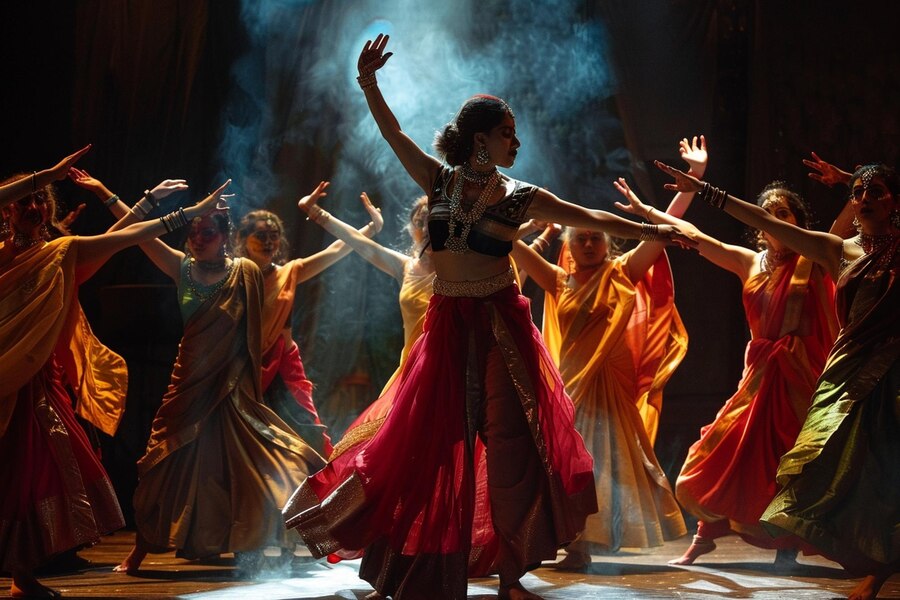Introduction
India is a land of rich cultural heritage, and one of its most enchanting aspects is its classical dance forms. These dances are not merely art forms but also a medium to narrate stories, convey emotions, and preserve traditions. In this article, we will explore the mesmerizing world of classical dance in India, delving into its history, various styles, and cultural significance.
The History and Evolution of Classical Dance in India
Origins and Ancient References
Classical dance in India traces its origins to ancient times, with references found in scriptures like the Natya Shastra by Bharata Muni, dating back to 200 BCE. This treatise is considered the foundation of Indian classical dance, detailing techniques, postures, and expressions.
Medieval Period and Patronage
During the medieval period, classical dance received significant patronage from royal courts and temples. The Chola and Vijayanagara dynasties, for instance, played a pivotal role in promoting and refining these dance forms.
Colonial Impact and Revival
The colonial era saw a decline in classical dance due to Western influence and societal changes. However, the early 20th century witnessed a renaissance, spearheaded by dedicated artists and scholars who revived these traditional forms.
Major Classical Dance Forms of India
Bharatanatyam
Originating from Tamil Nadu, Bharatanatyam is known for its grace, intricate footwork, and expressive gestures. It is traditionally performed by women and often depicts themes from Hindu mythology.
Kathak
Kathak hails from North India and is characterized by its intricate footwork, spins, and expressive storytelling. It evolved in both Hindu and Muslim courts, blending various cultural influences.
Kathakali
From the southern state of Kerala, Kathakali is a vibrant dance-drama known for its elaborate costumes, makeup, and masks. It primarily enacts stories from the Mahabharata and Ramayana.
Manipuri
Manipuri, from the northeastern state of Manipur, is a delicate and lyrical dance form. It often portrays episodes from the life of Lord Krishna and features graceful movements and traditional costumes.
Odissi
Odissi, originating from Odisha, is one of the oldest classical dance forms. It is distinguished by its fluid movements, sculpturesque poses, and spiritual themes, often depicted through the Geeta Govinda.
Kuchipudi
From Andhra Pradesh, Kuchipudi combines fast rhythms with fluid movements. It often involves dance dramas and requires strong theatrical skills, including singing and dialogue delivery.
Sattriya
Sattriya, from Assam, is a monastic dance form that evolved in the 15th century. It is deeply rooted in Vaishnavism and often narrates stories of Lord Krishna.
Elements and Techniques in Classical Dance
Mudras (Hand Gestures)
Mudras are a vital element in classical dance, used to convey complex emotions and narratives. Each gesture has a specific meaning and is used to enhance storytelling.
Abhinaya (Expression)
Abhinaya refers to the expressional aspect of dance, where dancers use facial expressions and body language to convey emotions and stories.
Nritta (Pure Dance)
Nritta focuses on rhythmic and technical aspects of dance, showcasing intricate footwork, patterns, and movements without any interpretive content.
Nritya (Expressive Dance)
Nritya combines rhythm and expression, where dancers use gestures, expressions, and movements to narrate a story or theme.
Cultural Significance and Influence
Religious and Spiritual Connections
Classical dance in India is deeply intertwined with religion and spirituality. Many performances are based on Hindu mythology and are often part of temple rituals and festivals.
Social and Cultural Impact
These dance forms also play a significant role in preserving and promoting Indian culture and traditions. They serve as a medium for education, storytelling, and cultural exchange.
Global Influence and Recognition
Indian classical dance has gained international recognition and influence. Renowned dancers and troupes have performed worldwide, contributing to global cultural appreciation.
Challenges and the Future of Classical Dance
Modernization and Preservation
While modernization poses challenges to preserving classical dance, efforts are being made to adapt these forms to contemporary contexts without losing their essence.
Education and Training
Institutes and academies across India are dedicated to teaching classical dance, ensuring that the knowledge and techniques are passed down to future generations.
Technological Integration
Technology is being leveraged to document, promote, and teach classical dance, making it more accessible to a global audience.
Conclusion
The classical dance forms of India are a testament to the country’s rich cultural heritage and artistic excellence. They are not just performances but a profound expression of India’s history, mythology, and spirituality. By understanding and appreciating these dance forms, we contribute to preserving an integral part of India’s cultural legacy.
FAQs
- What is the oldest classical dance form in India?
- Odissi is considered one of the oldest classical dance forms in India, with roots tracing back to ancient times and temple traditions.
- How many classical dance forms are there in India?
- There are eight recognized classical dance forms in India: Bharatanatyam, Kathak, Kathakali, Manipuri, Odissi, Kuchipudi, Sattriya, and Mohiniyattam.
- What is the Natya Shastra?
- The Natya Shastra is an ancient Indian treatise on performing arts, encompassing dance, music, and drama. It is attributed to the sage Bharata Muni and is considered the foundation of Indian classical dance.
- Can men perform classical dance in India?
- Yes, men can and do perform classical dance in India. Many classical dance forms, such as Kathakali and Kuchipudi, have traditionally involved male performers.
- How can one learn classical dance?
- One can learn classical dance by enrolling in a dance academy or school specializing in the chosen form. It requires rigorous training, practice, and dedication.










